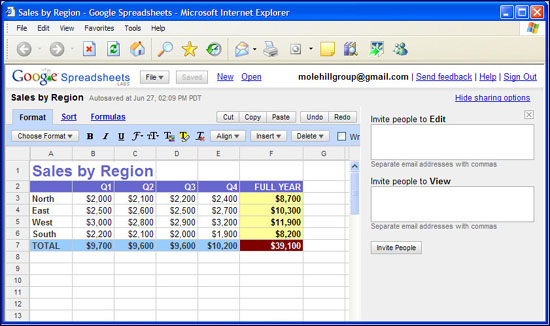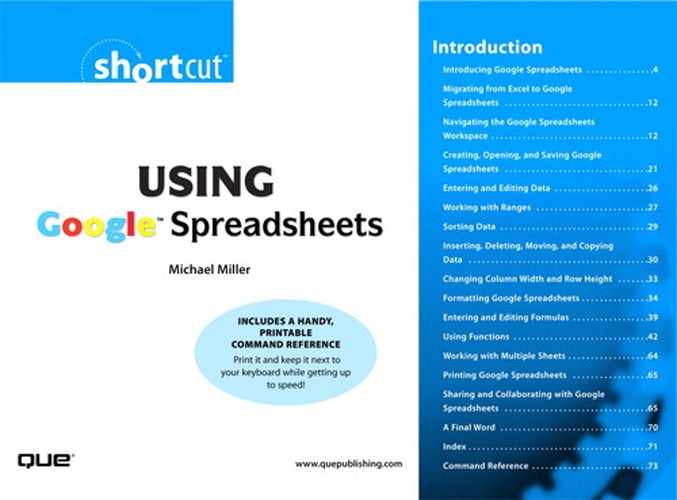Section 15. Sharing and Collaborating with Google Spreadsheets
The truly unique feature of Google Spreadsheets is the capability to share a spreadsheet with others—either for viewing or for collaborative editing. The only hitch to this process is that anyone you wish to share with must have their own Google Account to access the Google Spreadsheets site. That said, you can easily invite another users to create his or own new Google Account.
note
At present, there is no limit to the number of people with whom you can share a spreadsheet. The only requirement is that anyone you invite to share your spreadsheet have their own Google Account.
Sharing a Spreadsheet for Viewing
We'll start with the process of sharing a spreadsheet for viewing only. This lets other users view your spreadsheet but doesn't give them access to add or edit data. (It's a read-only process.)
To share a spreadsheet for viewing, follow these steps:
- From a saved spreadsheet, click the Show Sharing Options link; this opens the sharing pane, shown in Figure 41.
Figure 41 Getting ready to share a spreadsheet.

- In the Invite People to View box, enter the email addresses of the people you want to share the spreadsheet. (Separate multiple addresses with commas.)
- Click the Invite People button.
- This opens an Invitation window, like the one shown in Figure 42. Enter a personal message if you like, and then click the Send Invitation button.
Figure 42 Inviting another user to share a spreadsheet.

Your recipients now receive an invitation via email. The invitation contains a link to the spreadsheet; clicking this link opens the spreadsheet in a new browser window.
Anyone viewing your spreadsheet can not only navigate around the entire file (including multiple sheets within the spreadsheet file), but also save that file to their personal Google Spreadsheets online storage area or as an XLS-format file to their own PC. While viewing, other users will see the current work in progress; as soon as you press Enter when editing a cell, the edited contents will appear on the other users' screens. (They can't see the in-progress contents of the cell while you're editing the cell, however.)
Anyone you invite to view a spreadsheet can, in turn, invite other users to also view the spreadsheet.
Sharing a Spreadsheet for Collaboration
When you invite someone to view a spreadsheet, that's all they can do; they can navigate around the spreadsheet, but they can't add to or edit any of the data within the spreadsheet. If you want to collaborate with others on a spreadsheet, you must explicitly open the spreadsheet for collaboration.
caution
Google permits more than one user at a time to make changes to an open spreadsheet; the spreadsheet isn't "locked" when the first user starts editing. This can create havoc if both users try to make changes to the same data or aren't aware of the other changes being made. For this reason, you should always use caution while collaboratively editing a spreadsheet.
To share a spreadsheet for collaboration, follow these steps:
- From a saved spreadsheet, click the Show Sharing Options link; this opens the sharing pane.
- In the Invite People to Edit box, enter the email addresses of the people with whom you want to collaborate. (Separate multiple addresses with commas.)
- Click the Invite People button.
- This opens an Invitation window. Enter a personal message if you like, and then click the Send Invitation button.
Your recipients now receive an invitation via email. The invitation contains a link to the spreadsheet; clicking this link opens the spreadsheet in a new browser window. Once accessed, the other users can now edit the spreadsheet, in real time. In fact, multiple users can edit the spreadsheet at the same time; each person's edits appear on all the other users' screens as soon as they press the Enter key when editing a cell.
note
Anyone you invite to edit a spreadsheet can, in turn, invite other users to also edit the spreadsheet.
Chatting with Spreadsheet Viewers
As you can see in Figure 43, the view spreadsheet window that other users see includes a chat pane. This lets your viewers chat with you, in real time, while they're viewing your spreadsheet.
Figure 43 Chatting with other viewers/editors of your spreadsheet.

To view the chat pane in your own spreadsheet window, simply click the Chat With link at the top right of the window. You can close the chat pane at any time by clicking the resulting Hide Chat link.
While chatting, you enter your comments in the bottom text box. When you press Enter, your comments are sent to the other users and appear in the main text box in the chat pane.
Rescinding Access
If, at any time, you want to block a user from viewing or editing your spreadsheet, here's what to do:
- Click the Show Sharing Options link. The list of viewers now appears at the bottom of the sharing pane, as shown in Figure 44.
Figure 44 Removing a user from the viewing list.

- Click the Remove link next to the person for whom you want to rescind viewing/editing privileges.
That's it; the person you selected will no longer have access to this spreadsheet.
Versioning Your Work in Progress
When you're collaborating on a spreadsheet, it helps to keep different versions of the file on hand as you work; this lets you return to a previous version, if necessary.
Google Spreadsheets doesn't offer automatic versioning. In fact, as Google saves your changes as you make them, it's a little tricky to move backward through the different iterations of your work. However, there is a trick you can employ to add versioning to your spreadsheets. Here's how it works:
- When you're ready to create a new version, select File, Save As.
- When prompted, save the current file with a version after the name. For example, if the file is named spreadsheet1, you might save the current version as spreadsheet1v01 or spreadsheet1v02. You might even want to save the date as part of the filename, as in spreadsheet1 7-1-06v01.
- Any time you make a major change to the spreadsheet, repeat steps 1 and 2 and give the file a new version name.
Some users version their work once a day; others do it once an hour; still others do it whenever they add or change anything big in the spreadsheet. How often you save new versions is up to you, but the important thing is to save your work in multiple iterations. This will make it relatively easy to recover a previous version, if necessary.
